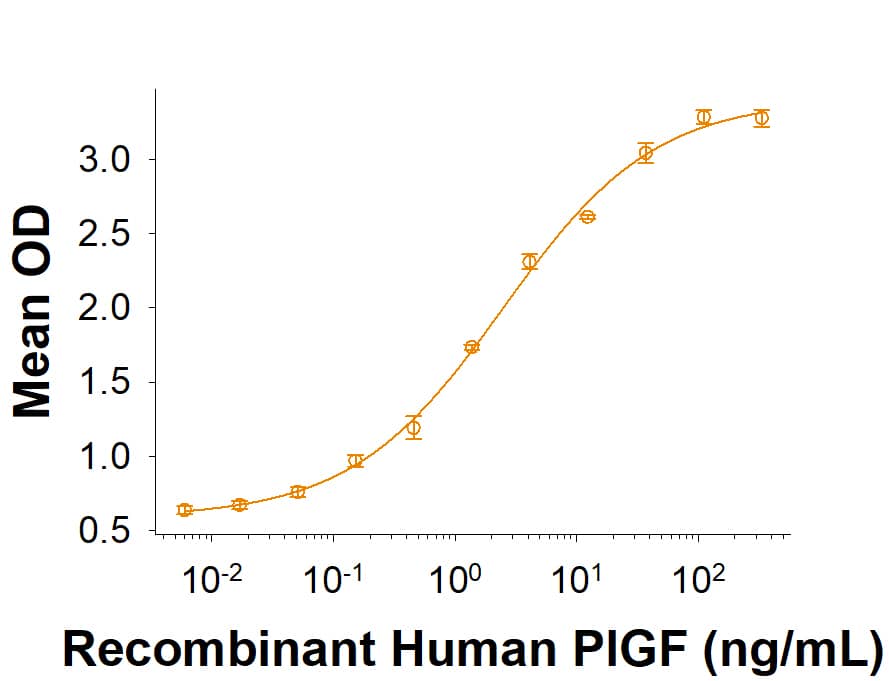Recombinant Human PlGF Protein
R&D Systems, part of Bio-Techne | Catalog # 264-PGB

Key Product Details
Source
Accession #
Structure / Form
Conjugate
Applications
Product Specifications
Source
Ala21-Arg149
Purity
Endotoxin Level
N-terminal Sequence Analysis
Predicted Molecular Mass
SDS-PAGE
Activity
When Recombinant Human VEGF R1/Flt‑1 Fc Chimera (Catalog # 3516-FL) is immobilized at 0.5 μg/mL, 100 μL/well, the concentration of Recombinant Human PlGF that produces 50% of the optimal binding response is approximately 0.75-4.5 ng/mL.
Scientific Data Images for Recombinant Human PlGF Protein
Formulation, Preparation and Storage
Carrier Free
What does CF mean?CF stands for Carrier Free (CF). We typically add Bovine Serum Albumin (BSA) as a carrier protein to our recombinant proteins. Adding a carrier protein enhances protein stability, increases shelf-life, and allows the recombinant protein to be stored at a more dilute concentration. The carrier free version does not contain BSA.
What formulation is right for me?In general, we advise purchasing the recombinant protein with BSA for use in cell or tissue culture, or as an ELISA standard. In contrast, the carrier free protein is recommended for applications, in which the presence of BSA could interfere.
Carrier: 264-PGB
| Formulation | Lyophilized from a 0.2 μm filtered solution in Acetonitrile and TFA with BSA as a carrier protein. |
| Reconstitution | Reconstitute at 200 μg/mL in 4 mM HCl. |
| Shipping | The product is shipped at ambient temperature. Upon receipt, store it immediately at the temperature recommended below. |
| Stability & Storage | Use a manual defrost freezer and avoid repeated freeze-thaw cycles.
|
Carrier Free: 264-PGB/CF
| Formulation | Lyophilized from a 0.2 μm filtered solution in Acetonitrile and TFA. |
| Reconstitution | Reconstitute at 200 μg/mL in 4 mM HCl. |
| Shipping | The product is shipped at ambient temperature. Upon receipt, store it immediately at the temperature recommended below. |
| Stability & Storage | Use a manual defrost freezer and avoid repeated freeze-thaw cycles.
|
Background: PlGF
References
- Hauser, S. and H.A. Weich (1993) Growth Factors 9:259.
- Maglione, D. et al. (1993) Oncogene 8:925.
- Eriksson, A. et al. (2002) Cancer Cell 1:99.
- Ribatti, D. (2008) Angiogenesis 11:215.
- Oura, H. et al. (2003) Blood 101:560.
- Roncal, C. et al. (2010) Cardiovasc. Res. 86:29.
- Levine, R.J. et al. (2004) N. Engl. J. Med. 350:672.
- Carmeliet, P. et al. (2001) Nat. Med. 7:575.
- Autiero, M. et al. (2003) Nat. Med. 9:936.
- Migdal, M. et al. (1998) J. Biol. Chem. 273:22272.
- Cheng, L. et al. (2004) J. Biol. Chem. 279:30654.
- Perelman, N. et al. (2003) Blood 102:1506.
- Cianfarani, F. et al. (2006) Am. J. Pathol. 169:1167.
- Maes, C. et al. (2006) J. Clin. Invest. 116:1230.
- Iwasaki, H. et al. (2011) PLoS One 6:e24872.
- Carnevale, D. et al. (2014) Immunity 41:737.
Long Name
Alternate Names
Gene Symbol
UniProt
Additional PlGF Products
Product Documents for Recombinant Human PlGF Protein
Product Specific Notices for Recombinant Human PlGF Protein
For research use only
